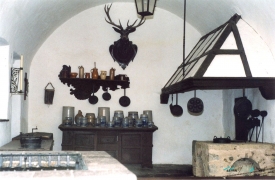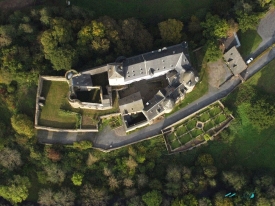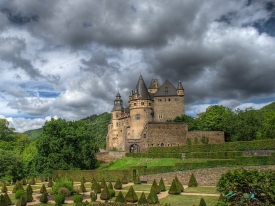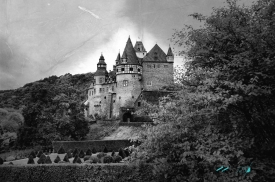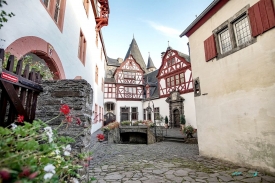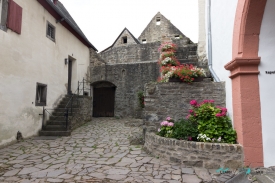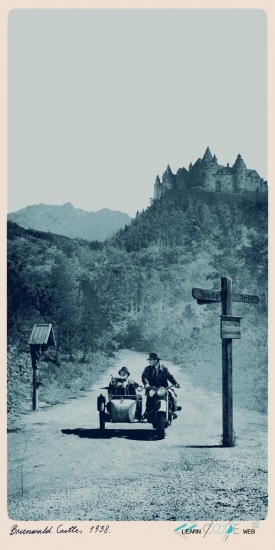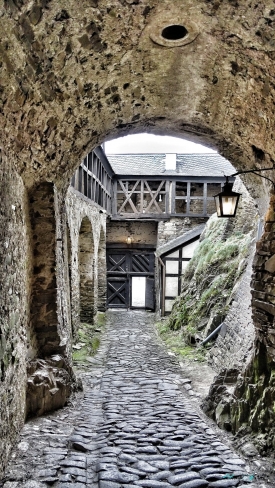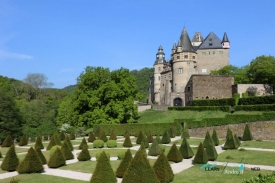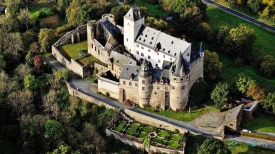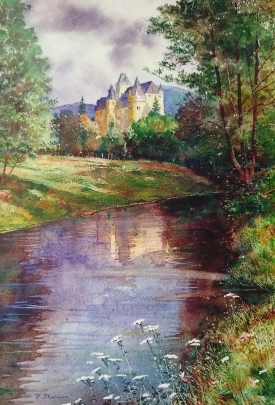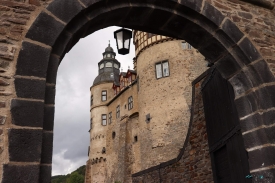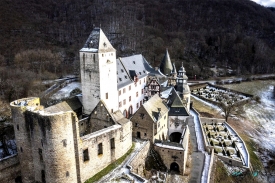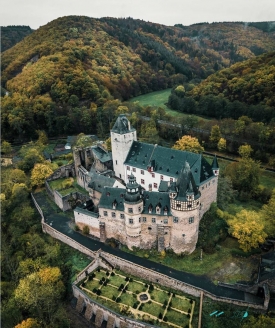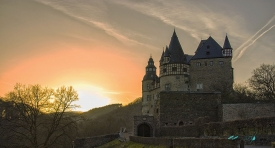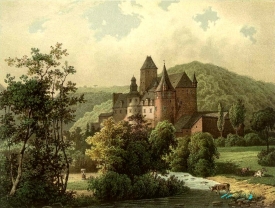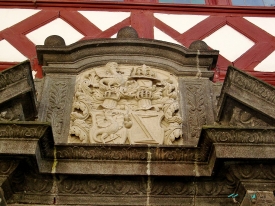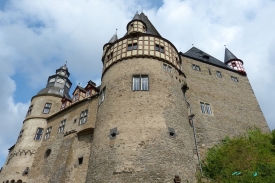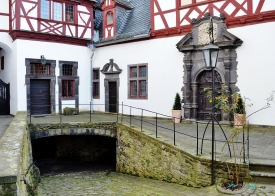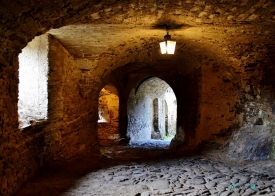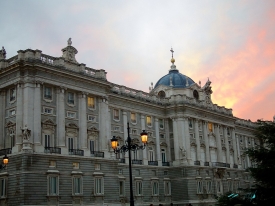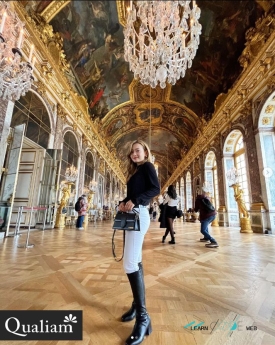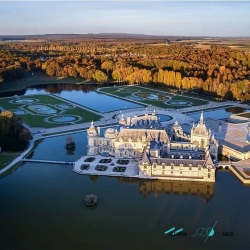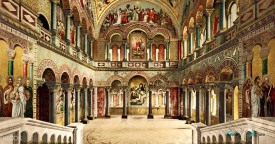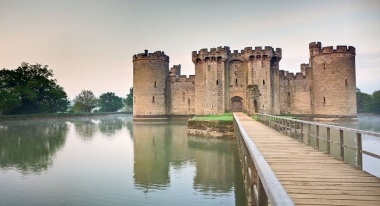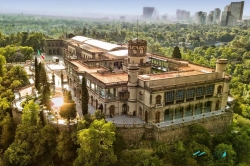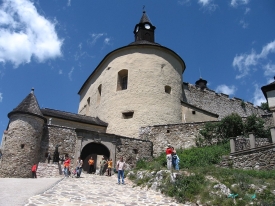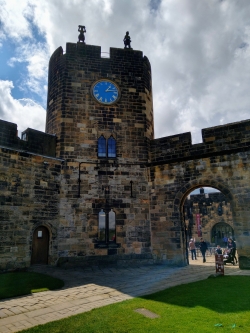ABOUT Burresheim Castle
Bürresheim Castle is northwest of Mayen on a rocky outcrop in the Nettetal. He belongs to the local community of Sankt Johann. Along with Eltz Castle and Lissingen Castle, it is one of the few complexes in the Eifel that were never conquered or devastated and were able to survive the wars of the 17th and 18th centuries and the social upheavals of the French Revolution unscathed.
Due to their unique location in the border area of the possessions of Electoral Cologne and Electoral Trier, these archbishoprics significantly influenced the history of the castle.
Built in the 12th century, Bürresheim was first mentioned in 1157 with its then-owners, the free noblemen Eberhard and Mettfried "de Burgenesem". Shortly before 1189, Eberhard's son Philipp sold his share to the Archbishop of Cologne, Philipp I von Heinsberg, only to receive it as a fief from him. The Archdiocese of Trier also recognized the importance of the complex and acquired the other half of the former castle under Archbishop Heinrich II von Finstingen.
In 1359, Vogte von Leutesdorf took over the Cologne fiefdom from the last representative of the Bürresheimers, while the Trier share passed to the Lords of Schöneck. Bürresheim thus became Ganerbenburg in the 14th century. The von Schönecks did not own the property for long, as Kuno von Schöneck and his son sold their share of the Bürresheim castle and lordship to Gerlach von Breidbach in 1473. At the beginning of the 16th century, Emmerich von Lahnstein received the rest of the of the bailiff of the castle.
Bürresheim Castle around 1860, Alexander Duncker Collection
Beginning in 1572, property disputes erupted around Lahnstein's estate, which could not even be settled by trial before the Imperial Chamber Court. It was not until 1659 that the parties reached an agreement and the von Breidbach family became sole owners of the castle complex. From then on, the family bore the name "von Breidbach-Bürresheim" and in 1691 was even raised to the status of baron of the realm. Its best-known representative was Emmerich Joseph von Breidbach-Bürresheim, from 1763 to 1774 Elector and Archbishop of Mainz. At the time of the Breidbach-Bürresheim barons, the imperial domain of Bürresheim included the castle, the towns of Sankt Johann, Rieden and Waldesch, the village of Nitz and the Bürresheim mills.
The family died out in 1796 with the death of the last male heir, Franz Ludwig Anselm Freiherr von Breitbach-Bürresheim, the chief magistrate of Koblenz and Ehrenbreitstein, who died while fleeing French troops. Bürresheim Castle was inherited by a grandson of the sister of the last Breidbach in Bürresheim, Count Klemens Wenzeslaus von Renesse, whose descendants continued to live in Bürresheim Castle. After the last occupant died in a car accident at the age of 32 and only 11 days after his marriage, the castle was inherited in 1921 by the family of Count von Westerholt. Only 17 years later, due to unfortunate circumstances, she was forced to sell Bürresheim Castle, including all furnishings, to the Provincial Association of the Prussian Rhine Province. The castle remained in his possession until 1948, when it passed into the care of the "Rhineland-Palatinate State Palace Administration", which handed it over to its successor organization "Rhineland-Palatinate Castles, Palaces, Antiquities" in 1998.
The complex, which is presented as a closed complex, did not acquire its current form until the fifteenth century. Previously there were two completely independent parts, not connected, of different sizes, which only had in common the 12th century Romanesque keep.
Bürresheim Castle was once protected by circular walls and two neck moats. The latter have now been filled in and only a few remnants of the ring walls remain.
The almost square keep is the oldest building in the palace complex. Previously only accessible through a high entrance, it can now be accessed via a flight of Baroque stairs built in the 17th century. It was probably enlarged in the 15th century and housed the porter's apartment on the fifth floor.
Because Bürresheim was in the hands of a single noble family for a long time, the castle owes its remarkable and unique interior, which includes pieces from late Gothic to historicism. Numerous portraits show members and relatives of the owning family and princes of bygone times. A unique testimony to the Rhenish nobility and living culture has been preserved to this day.
Among others, King Ludwig I of Bavaria and Kaiser Wilhelm II visited Bürresheim Castle.
Due to their unique location in the border area of the possessions of Electoral Cologne and Electoral Trier, these archbishoprics significantly influenced the history of the castle.
Built in the 12th century, Bürresheim was first mentioned in 1157 with its then-owners, the free noblemen Eberhard and Mettfried "de Burgenesem". Shortly before 1189, Eberhard's son Philipp sold his share to the Archbishop of Cologne, Philipp I von Heinsberg, only to receive it as a fief from him. The Archdiocese of Trier also recognized the importance of the complex and acquired the other half of the former castle under Archbishop Heinrich II von Finstingen.
In 1359, Vogte von Leutesdorf took over the Cologne fiefdom from the last representative of the Bürresheimers, while the Trier share passed to the Lords of Schöneck. Bürresheim thus became Ganerbenburg in the 14th century. The von Schönecks did not own the property for long, as Kuno von Schöneck and his son sold their share of the Bürresheim castle and lordship to Gerlach von Breidbach in 1473. At the beginning of the 16th century, Emmerich von Lahnstein received the rest of the of the bailiff of the castle.
Bürresheim Castle around 1860, Alexander Duncker Collection
Beginning in 1572, property disputes erupted around Lahnstein's estate, which could not even be settled by trial before the Imperial Chamber Court. It was not until 1659 that the parties reached an agreement and the von Breidbach family became sole owners of the castle complex. From then on, the family bore the name "von Breidbach-Bürresheim" and in 1691 was even raised to the status of baron of the realm. Its best-known representative was Emmerich Joseph von Breidbach-Bürresheim, from 1763 to 1774 Elector and Archbishop of Mainz. At the time of the Breidbach-Bürresheim barons, the imperial domain of Bürresheim included the castle, the towns of Sankt Johann, Rieden and Waldesch, the village of Nitz and the Bürresheim mills.
The family died out in 1796 with the death of the last male heir, Franz Ludwig Anselm Freiherr von Breitbach-Bürresheim, the chief magistrate of Koblenz and Ehrenbreitstein, who died while fleeing French troops. Bürresheim Castle was inherited by a grandson of the sister of the last Breidbach in Bürresheim, Count Klemens Wenzeslaus von Renesse, whose descendants continued to live in Bürresheim Castle. After the last occupant died in a car accident at the age of 32 and only 11 days after his marriage, the castle was inherited in 1921 by the family of Count von Westerholt. Only 17 years later, due to unfortunate circumstances, she was forced to sell Bürresheim Castle, including all furnishings, to the Provincial Association of the Prussian Rhine Province. The castle remained in his possession until 1948, when it passed into the care of the "Rhineland-Palatinate State Palace Administration", which handed it over to its successor organization "Rhineland-Palatinate Castles, Palaces, Antiquities" in 1998.
The complex, which is presented as a closed complex, did not acquire its current form until the fifteenth century. Previously there were two completely independent parts, not connected, of different sizes, which only had in common the 12th century Romanesque keep.
Bürresheim Castle was once protected by circular walls and two neck moats. The latter have now been filled in and only a few remnants of the ring walls remain.
The almost square keep is the oldest building in the palace complex. Previously only accessible through a high entrance, it can now be accessed via a flight of Baroque stairs built in the 17th century. It was probably enlarged in the 15th century and housed the porter's apartment on the fifth floor.
Because Bürresheim was in the hands of a single noble family for a long time, the castle owes its remarkable and unique interior, which includes pieces from late Gothic to historicism. Numerous portraits show members and relatives of the owning family and princes of bygone times. A unique testimony to the Rhenish nobility and living culture has been preserved to this day.
Among others, King Ludwig I of Bavaria and Kaiser Wilhelm II visited Bürresheim Castle.
The Best Pictures of Burresheim Castle
Videos of Burresheim Castle









